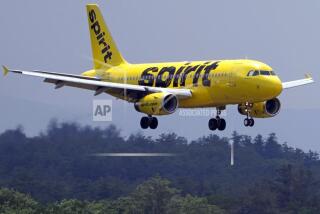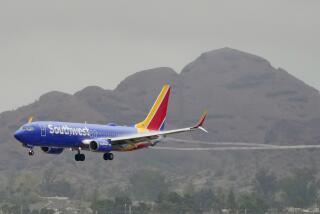The frill in flying is the ease of low-cost airlines
Sniping at the airlines seems to be a national pastime. But I refrain when it comes to the low-cost carriers, such as JetBlue, Southwest, Spirit, ATA, AirTran, Frontier, National, Midwest Express and America West. They make me want to go places I never considered, just because the price is right.
While the airlines duke it out for passengers, Iâm pleased to snap up plane tickets to Las Vegas or the Bay Area for the price of a massage. Suddenly, flying seems easier and more interesting. I can travel on the spur of the moment because several discount airlines, including ATA (American Trans Air) and JetBlue Airways, offer last-minute fares that are almost as inexpensive as 21-day advance purchase fares. At last, thanks to the little guys, one-way tickets can be affordable. (How the majors ever got away with charging full round-trip fares for one-way tickets I never will know.)
Flying on the low-cost carriers has introduced me to the pleasures of secondary airports -- Ontario, Burbank and Oakland -- that many of the smaller airlines use. I actually enjoy spending time at Long Beach Airport, endearingly dinky, uncongested and retro.
It seems easier to get help and attention precisely because the low-cost airlines are small. Last summer, when I needed to go to Washington, D.C., because of a death in the family, JetBlue quoted a price that was about $100 less than the price of a walk-up, though the airline had no standard discount prices for bereavement travel.
âThe budget airlines have better customer service because theyâre smaller and trying harder,â says Bob Kern, president of the Southern California chapter of the American Society of Travel Agents.
Above all, the smaller low-cost airlines often give consumers more choices. Gone are the days when I stuck with just one major carrier to accumulate frequent-flier miles. Now I like to fly around, getting to know a variety of budget carriers. Because I donât expect as much of them as I do of the majors, Iâm pleased with whatever I get.
And no two low-cost airlines are exactly alike. âEvery one has a different flavor,â says Ed Stewart, a spokesman for Southwest Airlines.
Southwest, JetBlue, National Airlines and Spirit Airlines are generally lumped together in the low-cost heap. But among even these four airlines there are telling differences.
Southwest, which started flying in 1971 between Dallas, Houston and San Antonio, is the model of a low-cost, no-frills airline. It doesnât offer meals or first and business class. Good cheer, if not assiduous service, can be expected of flight attendants. Longer trips usually require connections, and thereâs no reserved seating.
The cattle car approach depresses some travelers. But Southwest has so many flights on popular routes that travelers often can just go to the airport and catch a flight, knowing that if they miss one plane another probably will depart soon enough. Others who might drive or take a train for short hauls have found it cheaper to fly Southwest, says Michael Allen of Back Aviation Solutions, an airline consulting firm in New Haven, Conn.
JetBlue, with headquarters at John F. Kennedy International Airport in New York, put a new twist on the budget airline formula when it started up two years ago. The idea was to offer the same low fares as Southwest with a few more flourishes. These include new planes (Airbus A320s), a little more legroom and free live satellite TV. And then there are the little things: reserved seating; ramps at the rear and front of the aircraft to speed boarding and deplaning; beverages and snacks served by flight attendants using trays or baskets instead of carts to keep the aisles clear.
Spirit Airlines, of Fort Lauderdale, Fla., flies cross-country from L.A., Las Vegas and Oakland for as little as $218 round trip and is like Southwest in many respects. But in August it added an upgraded coach class, Spirit Plus, for travelers who want a few amenities, four-across leather seating and priority boarding. The service costs 20% to 30% more than coach, and last-minute upgrades to Spirit Plus are just $40 when available.
Surprisingly for a budget carrier, Las Vegas-based National tries to make comfort and service standard. The airline is currently in Chapter 11 (though National spokesman Dik Shimizu thinks it will be out of bankruptcy reorganization by mid-November). Until last year, hot meals were served on china in coach, though hard times since Sept. 11 have forced National to discontinue that.
Nationalâs advance-purchase fares for transcontinental flights (all of which stop in Las Vegas) might not take your breath away. But its last-minute walk-up fares for first class (with china) are less than half the price of first class on the majors. And thereâs no extra charge for adding a stop in Vegas.
Suddenly, flying is almost fun again. I can occasionally afford first class. I can go on a whim without breaking the bank. And, most revolutionary, I can speak of the airlines, especially the low-cost ones, without snarling.
More to Read
Sign up for The Wild
Weâll help you find the best places to hike, bike and run, as well as the perfect silent spots for meditation and yoga.
You may occasionally receive promotional content from the Los Angeles Times.






